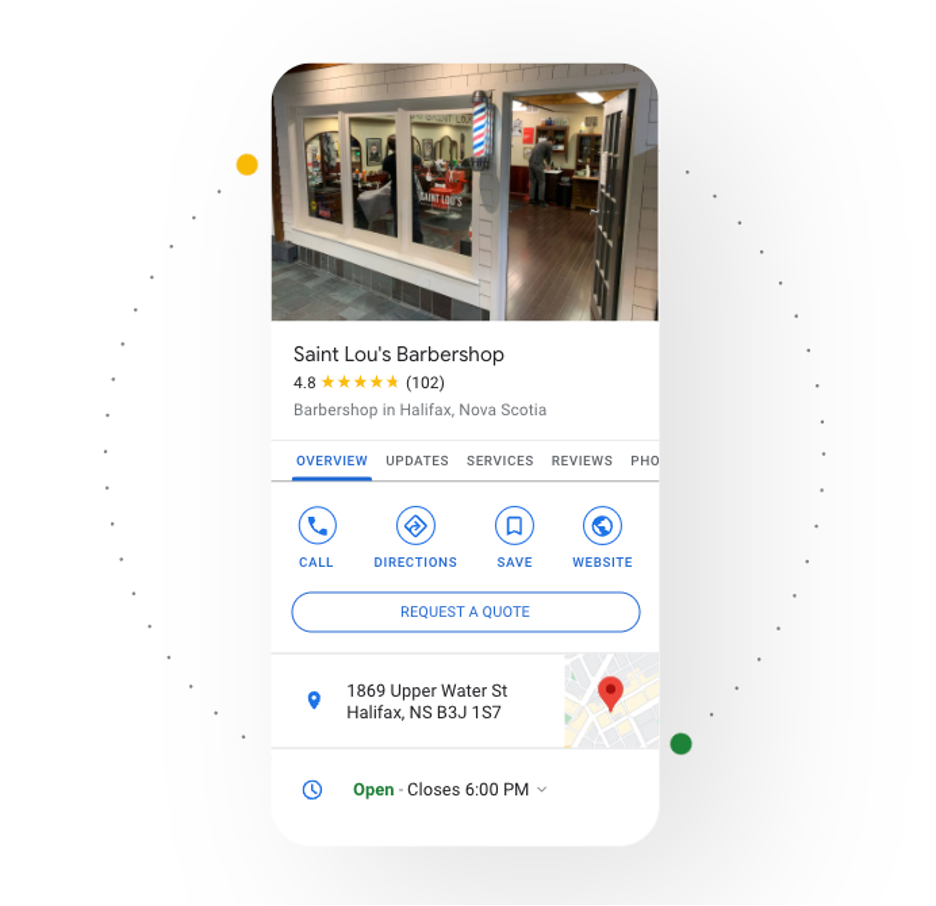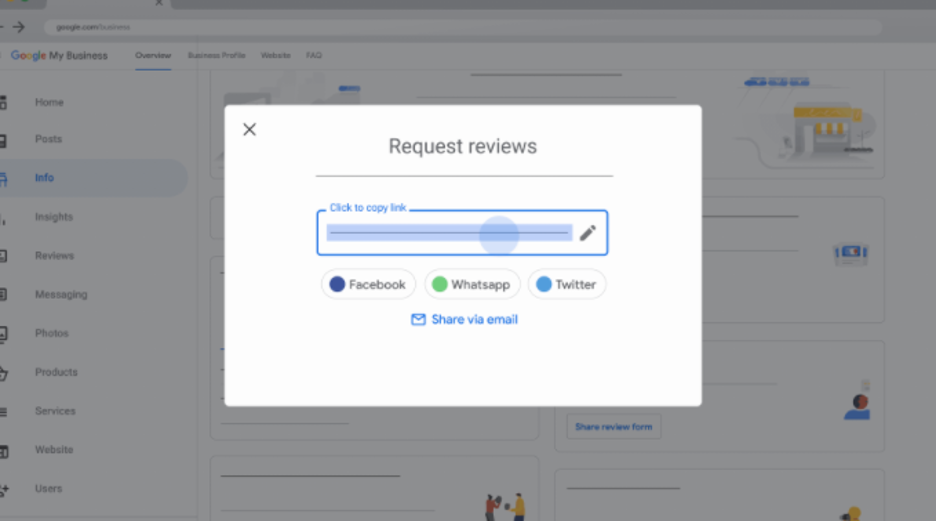Customer reviews can help sell your product or service more effectively than any sales copy.
Reading first-hand thoughts and opinions from other people is a crucial part of a customer’s journey.
It can make the difference between converting a customer or losing them to a competitor.
To that end, acquiring reviews needs to be treated as a priority – not an afterthought.
How often do you buy big-ticket items, or professional services, without reading reviews first?
If the answer is “never” or “rarely,” you’re among the majority of today’s consumers who follow the same path to purchase.
Online reviews are so important to the success of your business that they should be a core component of your marketing strategy, right up there with PR and advertising.
But where should you get started if you want to take control and make the most of the consumer’s voice?
Let’s talk about the top review platforms and the best way to leverage them.
1. Google Business Profile
Google Business Profile, previously known as Google My Business (GMB), is the starting point for any online review marketing strategy.
Reviews submitted to your Google Business Profile determine your star rating that customers see in Google Search & Maps results.
The total number of customer reviews, and overall star rating, is a key factor in ranking your Google Business Profile in the local pack within search results.
You’re wrong if you think this doesn’t affect you because your business is online instead of local.
Greater visibility in the local pack can lead to an increase in website traffic.
In one study that involved 30,000 sites, investing in reviews increased organic traffic from 5,500 to 8,000 in nine months.
But knowing that your Google profile needs reviews and actually earning them are two different things.
It should go without saying that an excellent product and superb customer service are a must here.
An emphasis on customer service should be part of your company culture. Customers are more likely to leave a review after a bad experience than a good one.
In addition to thoroughly vetting your customer service and developing the best product you can, there are additional steps you can take to get the most out of your Google Business Profile.
 Screenshot from google.com/business, December 2021
Screenshot from google.com/business, December 2021Let’s start with the obvious: You should set up a Google Business Profile, rather than let it sit unclaimed:
- Go to https://www.google.com/business/.
- Select or create the Google account you want to be associated with your business.
- Enter your name and address to search for your business.
- Click on the appropriate location.
- Click “Mail me my Code.” Google needs to verify your ownership of the physical location of your business. This is the simplest way to do it.
- Add high-quality photos to your profile, emphasizing what aspects of your business and your products can be communicated most effectively through visual media.
- Update all fields and descriptions and deck out your profile with the same care you would apply to your own website.
Now you will need to encourage your customers to leave you a review, and the most effective way to do that is to provide them with a direct link to where they can review your business.
Here’s how:
- On your computer, sign in to Business Profile Manager.
- If you have multiple profiles, open the profile you want to manage.
- In the left menu, click Home.
- In the “Get more reviews” card, you can copy your short URL to share with customers.
 Screenshot from support.google.com/business, December 2021
Screenshot from support.google.com/business, December 2021This is the link you will need to share with customers at common interaction points to encourage them to leave a review, especially during interactions where you have reason to believe you have a satisfied customer on your hands.
A Few More Tips For Getting Google Reviews
- Integrate your Google Business Profile review link into your email marketing campaigns. Use your email signature to ask your customers to leave reviews.
- Segment your audience and look for correlations between quantifiable interactions and customer lifetime value, and request reviews from those in your audience who are the most likely to be long-term customers.
- Make it a part of your training to teach all customer-facing staff to ask for reviews from customers, especially where customers seem to be satisfied.
- Where providing a direct link isn’t possible, have ready-made materials to teach customers how to leave reviews.
- Write personal emails that request reviews. The context of the personal email should make it clear that the email is not mass-produced.
2. Industry-Specific Review Sites
While industry-specific review sites don’t directly impact your star ratings in Google Maps and Google’s local search results, they have the potential to impact your reputation in search results.
Further, star ratings in non-local results are often visible in search snippets.
On top of that, 79% of consumers say they trust online reviews as much as personal recommendations from friends or family.
By every measure, the more reviews available, the better, which is why you want to earn as many reviews in as many places as possible.
Of course, that’s assuming your products and customer service are meeting the expectations of customers.
Irate customers can do serious damage to your brand reputation. So, it’s important to encourage reviews from a representative sample of your customer base.
Industry-specific review sites are sites built to cater to different verticals, such as Yelp for restaurants and TripAdvisor for hotels.
You can use the tips discussed above for earning Google reviews and simply apply them to these other platforms.
You can find a list of industry-specific review sites here and here, but you can and should also find industry-specific review sites by performing Google searches for:
- [your industry name] reviews/ratings.
- [your competitor name] reviews/ratings.
While there may be dozens of different review sites out there, it’s best to choose one to direct your customers to.
Customers will ultimately leave reviews wherever they want. But you can take efforts to funnel satisfied patrons to one location, such as being consistent with the review links you send to customers via email.
If you want to increase the volume of reviews across a range of review sites, this is best accomplished by rotating your review links rather than overloading customers with too many options.
3. Product Review Sites
Product review sites are third-party sites designed to help companies earn reviews while vetting them for accuracy.
The advantage of these sites is twofold:
- Customers are more likely to leave a review knowing it will be vetted and published by a third party.
- Customers may be more inclined to trust these reviews knowing they aren’t manipulated.
Acquiring a number of positive reviews on product review sites can generate more conversions and positive brand sentiment than reviews on other sites.
Of these, Trustpilot is arguably the go-to starting point – in large part because Google trusts it enough to include its product ratings in Google Shopping ads.
Another reason why Trustpilot is the de facto product review site is that the reviews cannot be modified to give brands an undeserved score.
Therefore, reviews on Trustpilot are likely to influence both brand perception and your reputation in Google.
One of the most helpful features a third-party review platform can bring to the table is the ability to incorporate reviews directly on your site (here’s how to do that with TrustPilot specifically).
A good product review site will also include the Schema markup necessary to get your star ratings listed in Google’s search results.
Taking advantage of product review sites allows you to take ownership of your brand’s story while being part of the conversation.
If you’re concerned about the fact that reviews on third-party sites won’t be 100% positive, consider the following online review statistics:
- On average, consumers require a business to have 40 online reviews before they believe its average star rating.
- The likelihood of a product getting purchased increases by 270% when it gets at least five reviews.
- 43% of shoppers say that text-based reviews influence their purchase decisions most vs. photos (33%) and video (24%).
- The average local business that appears on Google has 39 reviews.
- 82% of shoppers won’t choose a retailer with less than 3 stars.
4. Social Media
Facebook Business Pages have solidified that brands need to consider social media not only as a marketing outlet but as a place where customers review businesses.
 Screenshot from facebook.com/business/pages, December 2021
Screenshot from facebook.com/business/pages, December 2021Everything discussed in the above sections applies to social media as much as it does to Google Business Profiles, industry-specific review sites, and product review sites.
However, there are a few additional things to take into consideration.
Share Customer Reviews
Social media isn’t just a place where reviews are earned; it’s a place where reviews can be shared. The key is to do so tactfully.
When you share, retweet, post, and pin reviews from customers, it’s important to highlight the individual person leaving the review over your own brand.
When other social media users can see the person behind the review, it becomes more relatable.
Social media is a place where people keep up with their friends and loved ones, so it’s important to respect the platform for its intended use.
Respond To Online Reviews On All Your Platforms
Responding to reviews lets other customers know how they can expect to be treated when doing business with you.
Moreover, it’s called “social” media for a reason. Customers expect you to be part of the conversation.
This includes responding to negative reviews, as well.
Even the world’s most respected brands get negative reviews, so don’t be naive in thinking you’ll never get one.
With that said, it’s important to be proactive by developing a sound strategy for responding to negativity.
Otherwise, you risk creating a PR disaster by responding out of pure emotion.
Resolve Customer Issues Publicly On Social Media
If a customer complains publicly rather than bringing their concerns to you directly, it’s appropriate to resolve the issues publicly, as well.
If you’re asking a customer to contact customer support via email or send you a private message, onlookers may wonder what you’re trying to hide.
Keep in mind there are obvious lines that shouldn’t be crossed, such as revealing personal information the customer didn’t volunteer themselves.
But publicly acknowledging a customer’s needs is a good business practice compared to telling them to jump through another hoop to contact you more directly.
Although you should never give in to unreasonable demands, you should demonstrate how customers can expect to be treated by you.
Conclusion
Online reviews play a critical role in earning trust from today’s consumers and establishing a strong brand reputation.
No marketing strategy is complete without a plan for acquiring reviews and responding to them.
While brands can’t control what customers say and how they say it – there are ways to encourage more positive than negative reviews.
Sending out a call to action to satisfied customers is one way to increase the number of positive reviews.
Another way to create a positive perception of your brand is by responding to negative feedback and resolving complaints out in the open.
There’s no doubt these actions require additional work from you and your team, but they have long term benefits for your company that include:
- Building consumer trust.
- Managing brand reputation.
- Increasing conversion rates.
- Improving local search rankings.
- Generating organic search traffic.
- Gaining customers through word of mouth on social media.
Now, take what you’ve learned here to master the art of branding and stand out in today’s ultra-competitive marketplace.
Featured Image: Paulo Bobita/Search Engine Journal





